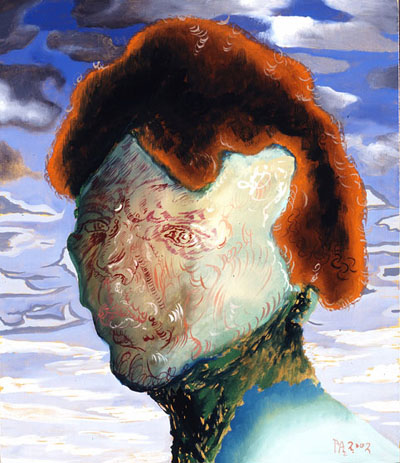 Self-portrait no. 59, 2002 oil on wooden panel, 50 x 43 cm Courtesy Galerie Bob van Orsouw, Zürich Philip Akkerman L'autoportrait, c'est moi Click for English text Philip Akkerman (1957), dessen Werke bereits in die Sammlungen des Stedelijk Museums, Amsterdam und des Hirshhorn Museums, Washington D.C. Eingang gefunden haben, malt ausschliesslich Selbstbildnisse. Seit 1981, dem Ende seines Kunststudiums an der Royal Academy in Den Haag und im Amsterdamer Atelier 63 bei Stanley Brouwn, verfertigt er jährlich um die hundert Porträts in frontaler oder Dreiviertel-Ansicht. Akkermans Beschränkung auf das eigene Konterfei, auf das, was durch den Blick in den Spiegel vertraut und rätselhaft zugleich wirkt, führt zu einer Erkundung der malerischen Möglichkeiten und Referenzen. Die in Öl auf kalkgrundierten Holztafeln ausgeführten Porträts legen Zeugnis ab von einem virtuosen Parcours durch die Kunstgeschichte. Von Rembrandt über van Gogh bis zur pointillistischen Auflösung der Physiognomie, von Beckmann über Picabia bis zur psychedelischen Verzerrung der Gesichtszüge, lassen sich Zitate, Epochen, Techniken und Stile ausmachen. Vergeblich sucht man in dem inzwischen auf mehr als über zweitausend klein- bis mittelformatige Selbstbildnisse angewachsenen Panoptikum nach Akkermans eigenem Stil. Denn der Künstler verwehrt sich einer Zuordnung oder einer für ihn typischen Handschrift: "In my work everything is possible! - today an idealist - tomorrow a formalist - forever: self-portraits!" In gewisser Weise ist Akkermans künstlerisches Verfahren konzeptuell angelegt. Durch die unausgesetzte Wiedergabe des eigenen Gesichts abstrahiert er von seinem Motiv, sodass die Physiognomie zu einer Art seriellem Träger wird, an dem sich eine stark variierende und äusserst produktive Malweise erproben lässt. In traditioneller Lasiertechnik gehalten und einem traditionellen Genre zugehörig lassen sich die Porträts jedoch nicht in herkömmlicher Weise lesen. Kopf und Gesicht sind durch diverse Inszenierungen und Verkleidungen einer ständigen Transformation ausgesetzt, wodurch sich die Bildnisse einer psychologischen Deutung und Wesensschau widersetzen. Sie explizieren nicht nur die multiplen Identitäten des Künstlers, sondern des Subjekts per se. Insofern erheben die Selbstporträts auch einen Anspruch auf Universalität: "I paint myself, and so I paint the whole of mainkind." Darüberhinaus zeugen sie von der unverhohlenen und obsessiven Lust Akkermans an der Malerei - ein Medium, das immer wieder totgesagt wurde: "Painting is not reigning anymore; but it is still raining paintings." Da Akkerman nach seinem Spiegelbild malt, blickt der Künstler forschend, oft auch mit suggestiver Dringlichkeit aus dem Bild heraus. Die existentielle wie künstlerische Frage, die Akkerman seit jeher umtreibt, wird damit auch zu einem Anliegen des Betrachters: "But why then do I paint self-portraits and not trees? I paint what is closest to me (as an uncomprehending individual): my own body, my own head." Birgid Uccia Zeitgleich mit der Ausstellung erscheint der Catalogue Raisonné "Philip Akkerman. 2314 Self-portraits 1891-2005" bei Veenman Publishers, Rotterdam. Ausstellungsdauer 11.3. - 15.4.2006 Öffnungszeiten Di-Fr 12 - 18 Uhr, Sa 11-16 Uhr und nach telefonischer Verabredung Galerie Bob van Orsouw Limmatstrasse 270 8005 Zürich Telefon +41 (0)44 273 11 00 Fax +41 (0)44 273 11 02 Email mail@bobvanorsouw.ch www.bobvanorsouw.ch Philip Akkerman L'autoportrait, c'est moi Philip Akkerman (1957), whose works have found their way into the collections of the Stedelijk Museum, Amsterdam and the Hirshhorn Museum, Washington D.C., paints self-portraits and only self-portraits. Since 1981 (the year that ended his studies at the Royal Art Academy in The Hague and with Stanley Brouwn at the Amsterdam Atelier 63) he has painted around one hundred portraits in full-frontal or three-quarters view every single year. Akkerman's restriction to his own countenance, to what a look in the mirror reveals to be both familiar and enigmatic, has led to an exploration of painting's possibilities and references. These portraits, painted in oil on chalk-primed wooden panels, bear witness to his virtuoso flypast through art history. From Rembrandt by way of van Gogh up to the pointillist dissolution of the physiognomy, from Beckmann by way of Picabia up to the psychedelic distortion of facial features - numerous quotations, epochs, techniques and styles can be found. One looks in vain for Akkerman's own style in the (in the meantime) over two thousand small-to middle-size self-portraits that have grown into a cabinet of curiosities, for the artist refuses to pin himself down to any categorization or signature style. "In my work everything is possible! - today an idealist - tomorrow a formalist - forever: self-portraits!" In a certain way, Akkerman's artistic method follows a conceptual plan. By means of the constant replication of his own face, he abstracts from his motif so that his physiognomy becomes a serial backdrop against which a highly varying and extremely productive way of working can be tested. Keeping to a traditional glazing technique and sharing a traditional genre, the portraits can nevertheless not be read in any conventional way. Head and face are subjected to constant transformation by means of diverse backdrops and (dis)guises, whereby the portraits resist any psychological interpretation and character relevation. They explicate not only the multiple identities of the artist, but of the subject as such. In this way the self-portraits also lay claim to universality: "I paint myself, and so I paint the whole of mankind." Beyond this they affirm the undisguised and obsessive joy Akkerman has in painting - a medium that has repeatedly been declared dead: "Painting is not reigning anymore, but it is still raining paintings." Since what Akkerman paints is his mirror image, the artist gazes out of the picture with a searching look, often also with suggestive penetration. The existential as well as aesthetic question that has driven Akkerman ever and again also becomes an issue with the viewer: "But why then do I paint self-portraits and not trees? I paint what is closest to me (as an uncomprehending individual): my own body, my own head." Birgid Uccia Exhibition 11 March - 15 April 2006 Gallery hours Tues-Fri noon - 6 pm, Sat 11 am - 5 pm |